
XXXI Simpósio Brasileiro de Telecomunicações
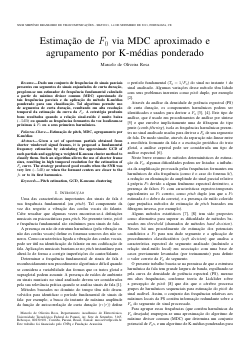
Estimação de F0 via MDC aproximado e agrupamento por K-médias ponderado
Marcelo de Oliveira Rosa
DOI: 10.14209/sbrt.2013.182
Keywords: Pitch estimation GCD K-means clustering
Abstract
Given a set of spectrum partials obtained from shorter windowed signal frames, it is proposed a fundamental frequency estimation by calculating the approximate GCD of such partials and applying a weighted K-means cluster method to classify them. Such an algorithm allows the use of shorter frame sizes, resulting in high temporal resolution for the estimation of F0 curve. The strategy produced good results when the SNR was very low (−5dB) or when the formant centers are closer to the f0 or to its first harmonicsDownload
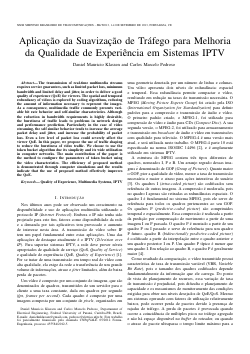
Aplicaçãao da Suavização de Tráfego para Melhoria da Qualidade de Experiência em Sistemas IPTV
Daniel Mauricio Klassen, Carlos Marcelo Pedroso
DOI: 10.14209/sbrt.2013.221
Keywords: Quality of Experience Multimedia Systems IPTV
Abstract
The transmission of real-time multimedia streams requires service guarantees, such as limited packet loss, minimum bandwidth and limited delay and jitter, in order to deliver a good quality of experience (QoE) for viewers. The spatial and temporal redundancy of videos is explored by coding algorithms, reducing the amount of information necessary to represent the images. As a consequence, multimedia traffic commonly presents variable bit rate behavior and self-similar characteristics. Although the reduction in bandwidth requirements is highly desirable, the burstiness of traffic leads to problems in network design and performance prediction. Particularly in the case of video streaming, the self similar behavior tends to increase the average packet delay and jitter, and increase the probability of packet loss. Even a low level of packet loss could severely affect the viewer QoE. In this paper, we propose the use of traffic shaping to reduce the burstiness of video traffic. We choose to use the token bucket algorithm due its simplicity and its wide utilization in computer networks. The main contribution of the paper is the method to configure the parameters of token bucket using the video characteristics. The efficiency of proposed method is demonstrated through computer simulations and the results indicate that the use of proposed method effectively improves the QoE.Download
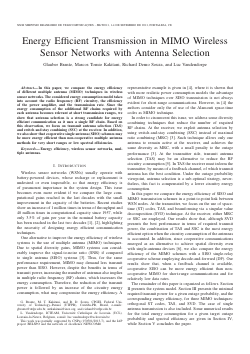
Energy Efficient Transmission in MIMO Wireless Sensor Networks with Antenna Selection
Glauber Brante, Marcos Tomio Kakitani, Richard Demo Souza, Luc Vandendorpe
DOI: 10.14209/sbrt.2013.185
Keywords: Energy efficiency wireless sensor networks multiple antennas.
Abstract
In this paper, we compare the energy efficiency of different multiple antenna (MIMO) techniques in wireless sensor networks. The considered energy consumption model takes into account the radio frequency (RF) circuitry, the efficiency of the power amplifier, and the transmission rate. Since the energy consumption of the additional RF chains required by each antenna becomes relevant at short transmission ranges, we show that antenna selection is a strong candidate for energy efficient communication as it uses a single RF chain. Based on this observation, we focus on transmit antenna selection (TAS) and switch and stay combining (SSC) at the receiver. In addition, we also show that cooperative single antenna (SISO) schemes may be more energy efficient than non-cooperative multiple antenna methods for very short ranges or low spectral efficiencies.Download
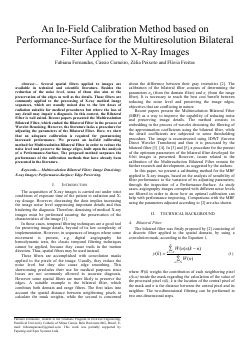
An In-Field Calibration Method based on Performance-Surface for the Multiresolution Bilateral Filter Applied to X-Ray Images
Fabiana Fernandes, Cássio Carneiro, Zélia Peixoto, Flávia Freitas
DOI: 10.14209/sbrt.2013.222
Keywords: Multiresolution Bilateral Filter; Image Denoising; X-ray Images; Performance-Surface; Edge Preserving
Abstract
Several spatial filters applied to images are available in technical and scientific literature. Besides the reduction of the noise level, some of them also aim at the preservation of the edges as well as the details. Those filters are commonly applied to the processing of X-ray medical image sequences, which are usually noised due to the low doses of radiation suitable for medical procedures but where the loss of any detail may impair a diagnosis. In this context, the Bilateral Filter is well suited. Recent papers presented the Multiresolution Bilateral Filter, which embed the Bilateral Filter in the process of Wavelet Denoising. However, the literature lacks a procedure for adjusting the parameters of the Bilateral Filter. Here, we show that an adequate calibration is required for guaranteeing increased performance. We present an in-field calibrating method for Multiresolution Bilateral Filter in order to reduce the noise level and preserve the image edges, built upon the analysis of a Performance-Surface. The proposed method surpasses the performance of the calibration methods that have already been presented in the literature.Download
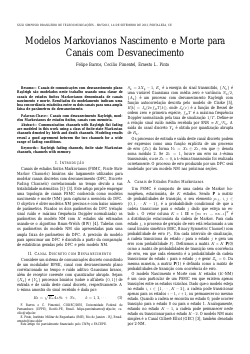
Modelos Markovianos Nascimento e Morte para Canais com Desvanecimento
Felipe Barros, Cecilio Pimentel, Ernesto L. Pinto
DOI: 10.14209/sbrt.2013.188
Keywords: Rayleigh fading channels finite state Markovian channels channels with memory
Abstract
Communication channels with Rayleigh flat fading are modeled in this work using a class of finite-state Markovian channels denoted by birth and death channels. Modeling results reveal a good agreement between the two channels for a wide range of fading conditions.Download
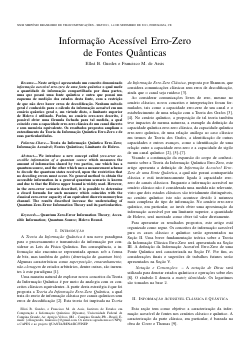
Informação Acessível Erro-Zero de Fontes Quânticas
Elloá B. Guedes, Francisco M. de Assis
DOI: 10.14209/sbrt.2013.223
Keywords: Quantum Zero-Error Information Theory; Accessible Information; Quantum Source; Holevo Bound.
Abstract
We introduce a new concept called zero-error accessible information of a quantum source which measures the amount of information shared by two parties, one which has a quantum source, and the other which uses a measurement scheme to decode the quantum states received, upon the restriction that no decoding errors must occur. No general method to obtain the accessible information in a general quantum scenario is known and due to that the Holevo upper bound is widely used. However, in the zero-error scenario described, it is possible to determine a closed formula for such measure which coincides with the classical zero-error capacity of an equivalent discrete memoryless channel. The results described increase the understading of Quantum Zero-Error Information Theory and its particularities.Download
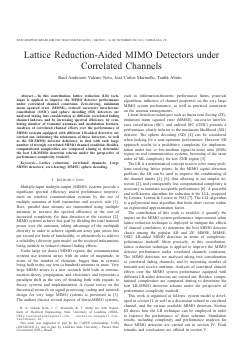
Lattice Reduction-Aided MIMO Detectors under Correlated Channels
Raul Ambrozio Valente Neto, José Carlos Marinello, Taufik Abrão
DOI: 10.14209/sbrt.2013.246
Keywords: Lattice reduction correlated channels Large MIMO detectors zero-forcing MMSE sphere decoding.
Abstract
In this contribution, lattice reduction (LR) technique is applied to improve the MIMO detector performance under correlated channel constrains. Zero-forcing, minimum mean squared error (MMSE), ordered successive interference cancellation (OSIC) and sphere decoding (SD) detectors are analysed taking into consideration a) different correlated fading channel indexes, and b) increasing spectral efficiency, by combining number of transmit antennas and modulation formats. Analyses of correlated channel effects over the performance of MIMO systems equipped with different LR-aided detectors are carried out, indicating the robustness of those detectors, as well as the SD-MIMO detector deficiency to deal with such large number of strongly correlated MIMO channel condition. Besides, computational complexities are compared aiming to determine the best LR-MIMO detection scheme under the perspective of performance-complexity tradeoffDownload
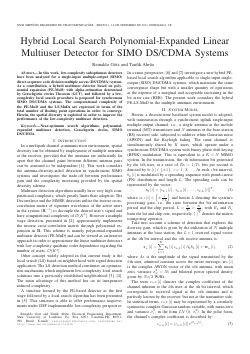
Hybrid Local Search Polynomial-Expanded Linear Multiuser Detector for SIMO DS/CDMA Systems
Reinaldo Götz, Taufik Abrão
DOI: 10.14209/sbrt.2013.225
Keywords: Near-optimum search algorithms polynomialexpanded multiuser detection Gerschgorin circles SIMO DS/CDMA.
Abstract
In this work, low-complexity suboptimum detectors have been analyzed for a single-input multiple-output (SIMO) direct-sequence code division multiple access (DS/CDMA) system. As a contribution, a hybrid multiuser detector based on polynomial expansion (PE-MuD) with alpha-estimation determined by Gerschgorin circles Theorem (GCT), and followed by a lowcomplexity local search procedure is proposed for synchronous SIMO DS/CDMA systems. The computational complexity of the PE-MuD and the LS-MuDs are expressed in terms of the total number of floating point operations in order to converge. Herein, the spatial diversity is exploited in order to improve the performance of the low-complexity multiuser detectors.Download
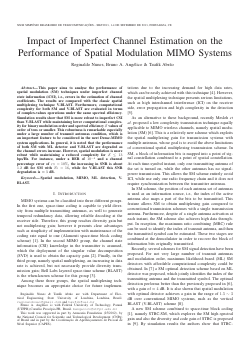
Impact of Imperfect Channel Estimation on the Performance of Spatial Modulation MIMO Systems
Reginaldo Nunes, Bruno A. Angélico, Taufik Abrão
DOI: 10.14209/sbrt.2013.231
Keywords: Spatial modulation MIMO ML detection VBLAST.
Abstract
This paper aims to analyse the performance of spatial modulation (SM) techniques under imperfect channel state information (iCSI), i.e., errors in the estimation of channel coefficients. The results are compared with the classic spatial multiplexing technique V-BLAST. Furthermore, computational complexity for both SM and V-BLAST are evaluated in terms of complex-values operations under the same spectral efficiency. Simulation results show that SM is more robust to imperfect CSI than V-BLAST while maintaining lower computational complexity for binary modulation order and spectral efficiency S values of order of tens or smaller. This robustness is remarkable especially under a large number of transmit antennas condition, which is an important feature to be considered in the next Dense-MIMO system applications. In general, it is noted that the performance of both SM with ML detector and V-BLAST are degraded as the channel errors increase. However, spatial modulation is more robust while maintaining a reduced complexity for S ≤ 13 bps/Hz. For instance, under a BER of 10−4 and a channel percentage error of ε% = 10%, the increasing in SNR is about 1.2 dB for SM with Nt = 16, while for V-BLAST this SNR degradation is ≈ 3 dB.Download
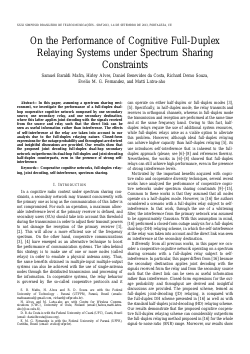
On the Performance of Cognitive Full-Duplex Relaying Systems under Spectrum Sharing Constraints
Samuel Baraldi Mafra, Hirley Alves, Daniel Benevides da Costa, Matti Latva-aho, Richard Demo Souza, Evelio M. G. Fernandez
DOI: 10.14209/sbrt.2013.226
Keywords: Cooperative cognitive networks full-duplex relaying joint decoding self-interference spectrum sharing
Abstract
In this paper, assuming a spectrum sharing environment, we investigate the performance of a full-duplex dualhop cooperative cognitive network composed by one secondary source, one secondary relay, and one secondary destination, where this latter applies joint decoding with the signals received from the source and relay such that the direct link can be seen as useful information rather than interference. The effects of self-interference at the relay are taken into account in our analysis due to the full-duplex relaying nature. Closed-form expressions for the outage probability and throughput are derived and insightful discussions are provided. Our results show that the proposed joint decoding full-duplex dual-hop secondary network outperforms its dual-hop full-duplex and joint-decoding half-duplex counterparts, even in the presence of strong selfinterference.Download